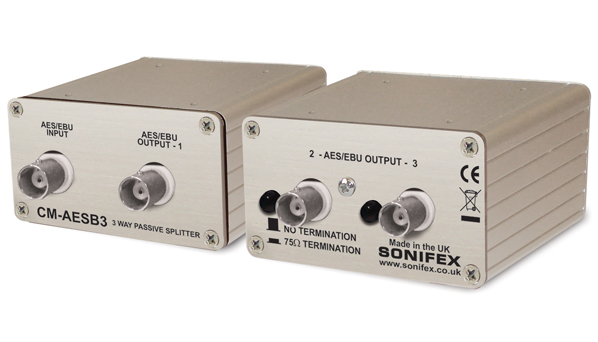Press Release
Sonifex Announce 3 Way Splitters
16th October 2013

CM-AESB3 Single 3 Way Passive AES3ID Splitter With BNC Connectors.
New products being announced by Sonifex are three transformer based passive splitter products. Following on from the release last month of Redbox rack-mount units, individual splitters have been announced with availability during November 2013.
Eamonn Heffernan, Sales Manager of Sonifex commented: " Our new small form, single three way splitters are robust, high quality units housed in aluminium and they require no power to operate. They use very high quality audio transformers to give top quality performance and galvanic isolation."
The CM-AESB3
is a passive “one-to-three” splitter designed to split a single AES3ID digital audio source to up to three destinations, using female BNC connectors. Particularly useful in a video production and broadcast environment, the CM-AESB3 splits the input signal through high quality transformers. 75Ω termination can be applied, if desired, to unconnected outputs to maintain optimum carrier parameters.
The CM-AESX3 is similarly a passive “one-to-three” splitter used to create multiple AES3 digital audio signals from a single source, using Neutrik XLR connectors.
It provides solutions to a range of digital signal distribution problems, where correct termination is essential to maintain signal integrity and 110Ω termination can be applied to unconnected outputs.
The CM-MS3 can split a single microphone or line source to up to three destinations, using Neutrik XLR connectors. It uses high quality audio transformers that are capable of accepting input levels up to +18dBu, making the splitter useful in both microphone and line level splitting applications.
The CM-MS3 offers three methods of providing phantom power to a microphone connected to its input: from the external +48VDC power connector; from a microphone amplifier connected to output 1 (direct); from a microphone amplifier connected to output 2 (phantom loopback).
Controlling which method is used to provide phantom power is achieved with simple push switches. It is possible to concurrently power a microphone using any two of the above methods without degrading audio performance, thus providing power supply redundancy.
Also, ground loop hum problems can be quickly eliminated using the push switches to lift pin 1 of the output connectors (output 2 and 3 only).
-ends-
